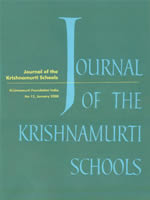Issue 12 - January 2008
- Written by J. Krishnamurti
Teachers or educators are human beings. Their function is to help the student to learn not only this or that subject, but to understand the whole activity of learning; not only to gather information about various subjects, but primarily to be complete human beings.
- Written by Alok Mathur
The world over, we lament the state of education. We might observe directly the plight of a generation of young people weighed down by the burden of seemingly meaningless academic curricula and indifferent teaching practices, alongside spiralling aspirations for securing the ‘good life’.
- Written by P. Krishna
Science and Society Though modern science is of relatively recent origin in human history, it has made very rapid progress and transformed outwardly the manner of our living.
- Written by Shailesh Shirali
In the silence of deep night and in the quiet still morning when the sun is touching the hills, there is a great mystery.
- Written by N. J. Krishnan
I am sure all of us have had occasions when we have felt a sense of dissatisfaction; days when we wonder why we are doing what we are doing, days when we wonder whether it is any use at all, whether teachers have anything to do with the learning of the child.
- Written by T. M. Krishna
As Indians, we honestly believe that culture is in our blood and that this gives us an edge over other nationalities.
- Written by Patrick Foster
The U.S. has its own history and tradition of vocational education.
- Written by Radhika Neelakantan
Art will remain the most astonishing activity of mankind born out of struggle between wisdom and madness, between dream and reality in our mind.
- Written by G. Gautama
The formation called Chakravyuha was used in one of the battles of the Mahabharata.
- Written by Anya Van Zijll Langhout
The story of life is lived by us. It is experienced first hand from day to day.
- Written by V. Arun
This article is based on my experience of teaching Environmental Education for Classes 9 and 10 for the past ten years.
- Written by V. Shantaram
Teaching environmental education has been part of our curriculum at the Rishi Valley School well before the subject was made mandatory for all students as per the orders of the Supreme Court.
- Written by Sudha Premnath
It is nine in the morning at Kalligutta, a remote tribal settlement just outside the Kaundinya Wildlife Sanctuary, Andhra Pradesh.
- Written by Yasmin Jayathirtha
It is almost received wisdom in alternative schools and other similar communities that rules are antigrowth; they restrict creativity and stifle the true cooperative spirit.
- Written by A. Kumarasamy
There is an implicit assumption widely shared by teachers in the Krishnamurti schools that preparing students to face examinations shifts focus away from learning a subject.
- Written by Krishna H.
‘May we please go outside?’ a student pleads, batting eyelids as I walk into a noisy room of fifteen-year-olds.
- Written by Akhila Seshadri and S. Padmavathy
This article is an account of a pilot project on learning in a mixed age group environment in the middle school classes 5, 6 and 7, initiated at The School, KFI, in Chennai in the year 2006-2007.
- Written by Raji Swaminathan
Teachers often see research as involving distance and separation from their work.


